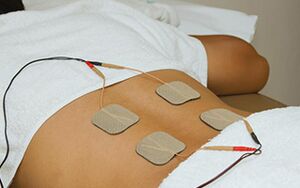Microcurrent Electrical Neuromuscular Stimulation
Original Editor - User Name
Top Contributors - Yahya Al-Razi and Angeliki Chorti
Introduction[edit | edit source]
Microcurrent electrical neuromuscular stimulation (MENS) was developed as a physical therapy modality delivering current in the microampere range. It has been reported that MENS has several physiological effects such as pain relief (Larner and Kirsch, 1981) and facilitation of tissue repair including tendon injuries (Nessler and Mass, 1987; Owoeye et al., 1987), skin ulcers (Gault and Gatens, 1976; Wolcott et al., 1969), wounds (Byl et al., 1994; Huckfeldt et al., 2007), bedsores (Carley and Wainpel, 1985) and ligament injuries (Miyazaki et al., 2007). Recently, we have confirmed that the regrowth of unloading-associated atrophied mouse soleus muscle is stimulated by MENS (Ohno et al., 2013). Previous studies (Curtis et al., 2010; Lambert et al., 2002) have suggested that MENS facilitates a repair of injured skeletal muscle and shortens the recovery period. However, it is still unclear whether MENS has stimulating effects on activation of regenerative potential in injured skeletal muscle.
KEY POINTS :
- Microcurrent electrical neuromuscular stimulation (MENS) facilitated the recovery of the relative muscle dry weight, the relative muscle protein content, and the mean cross-sectional areas of muscle fibers of injured TA muscle in mice.
- The number of satellite cells was increased by MENS during the regenerating phase of injured skeletal muscle.
- Decrease in the percentages of fibers with central nuclei was facilitated by MENS.
- MENS may facilitate the regeneration of injured skeletal muscles.[1]
Current specification[edit | edit source]
Biophysical effects[edit | edit source]
Therapeutic effects[edit | edit source]
Indications[edit | edit source]
Contraindications[edit | edit source]
Microcurrent Electrical Neuromuscular Stimulator[edit | edit source]
Resources[edit | edit source]
- bulleted list
- x
or
- numbered list
- x
References[edit | edit source]
- ↑ Fujiya H, Ogura Y, Ohno Y, Goto A, Nakamura A, Ohashi K, Uematsu D, Aoki H, Musha H, Goto K. Microcurrent electrical neuromuscular stimulation facilitates regeneration of injured skeletal muscle in mice. Journal of sports science & medicine. 2015 Jun;14(2):297.







